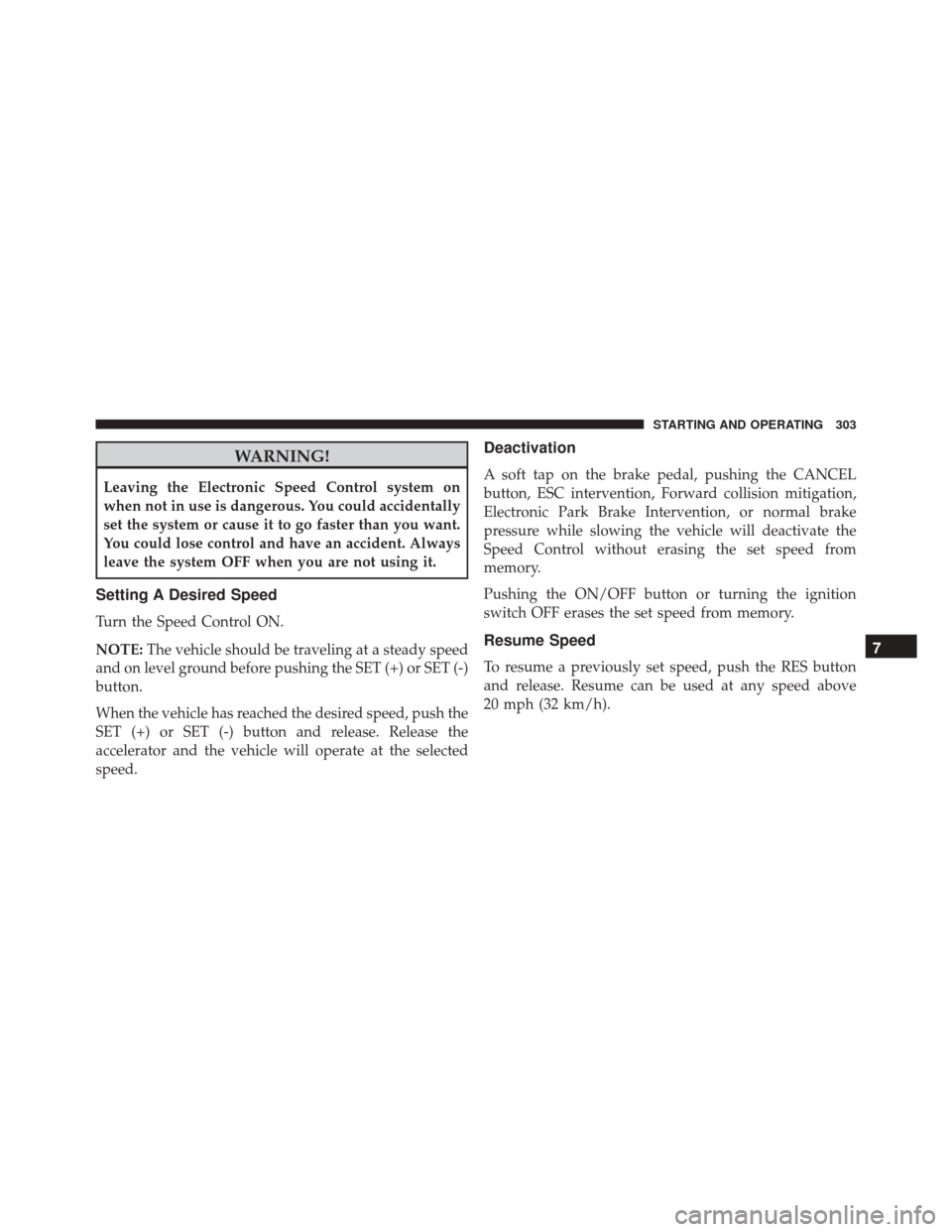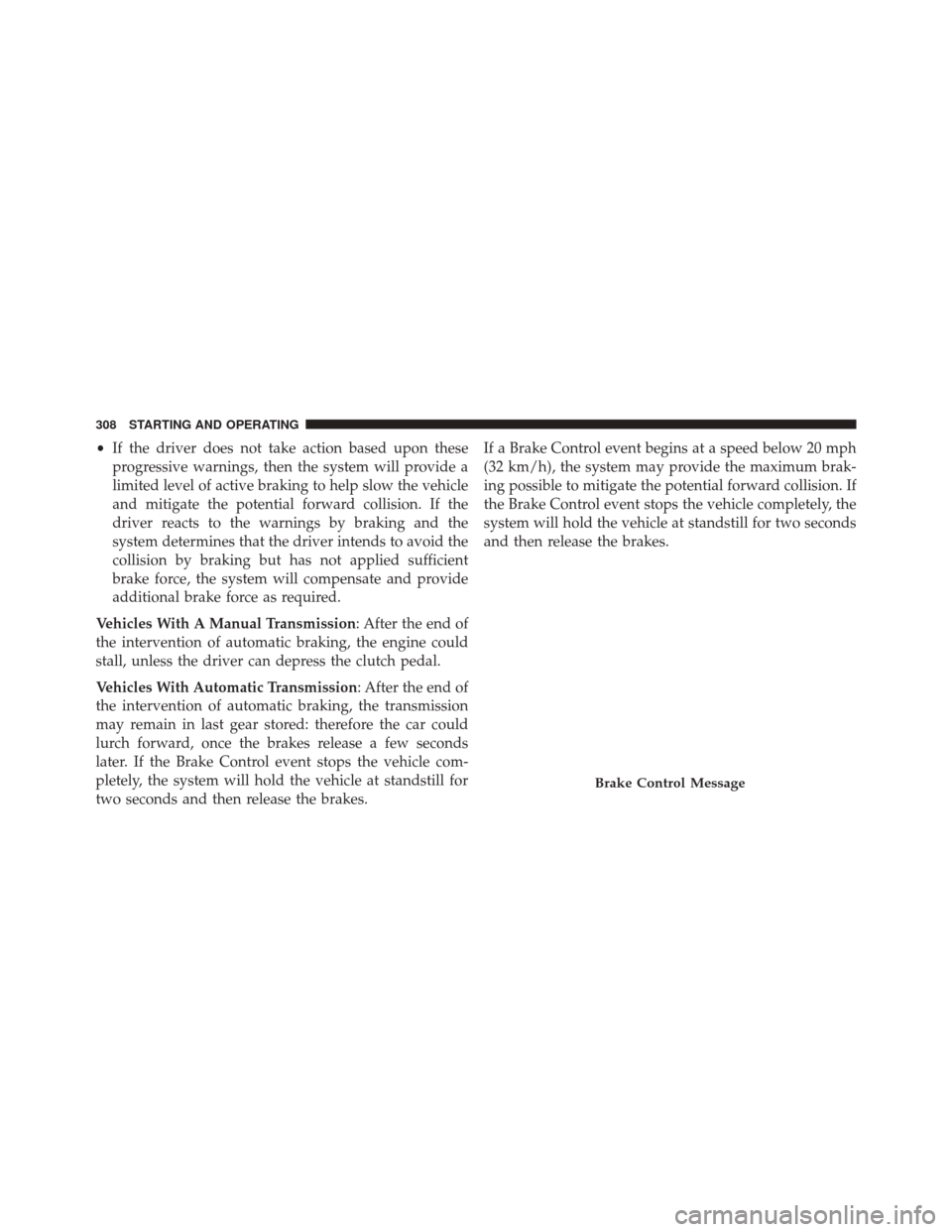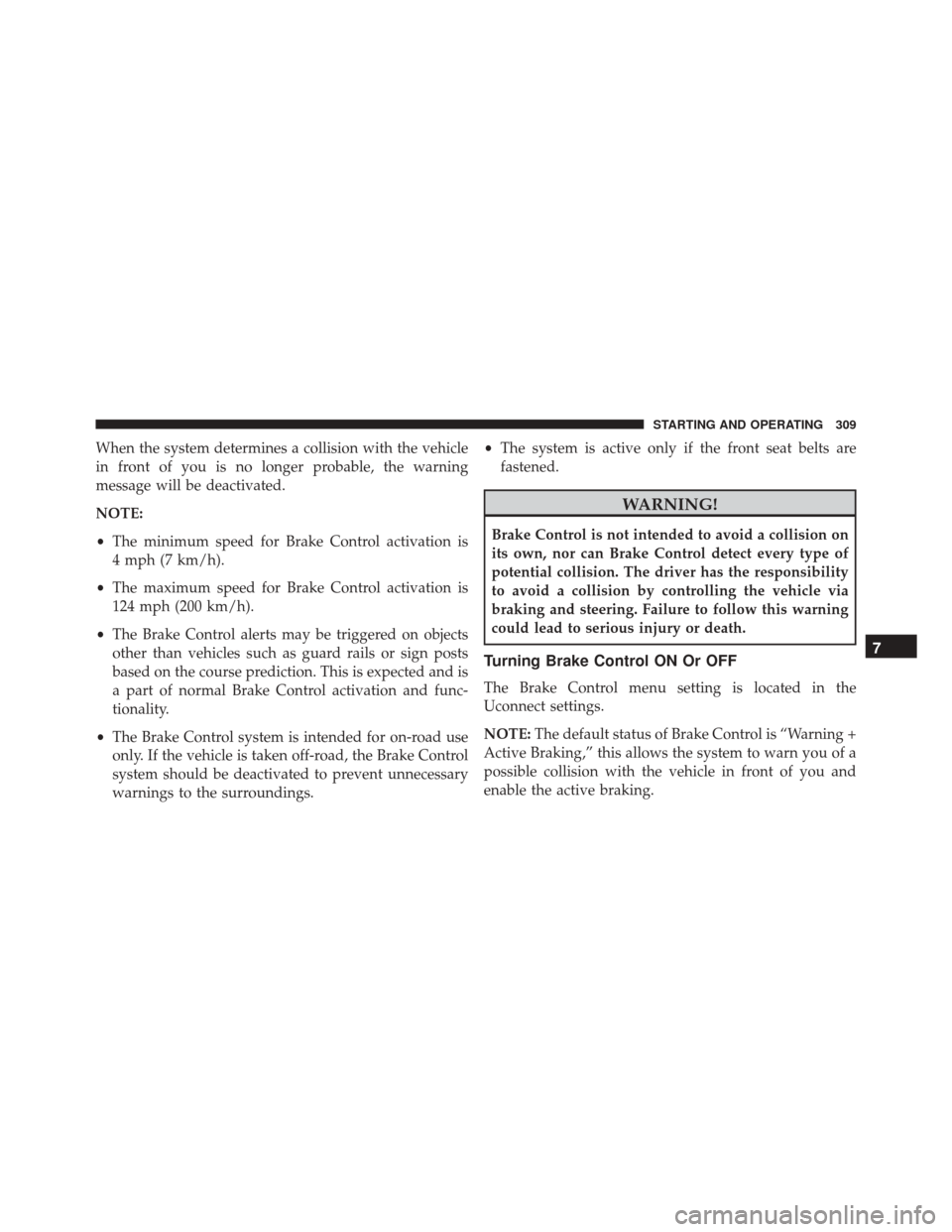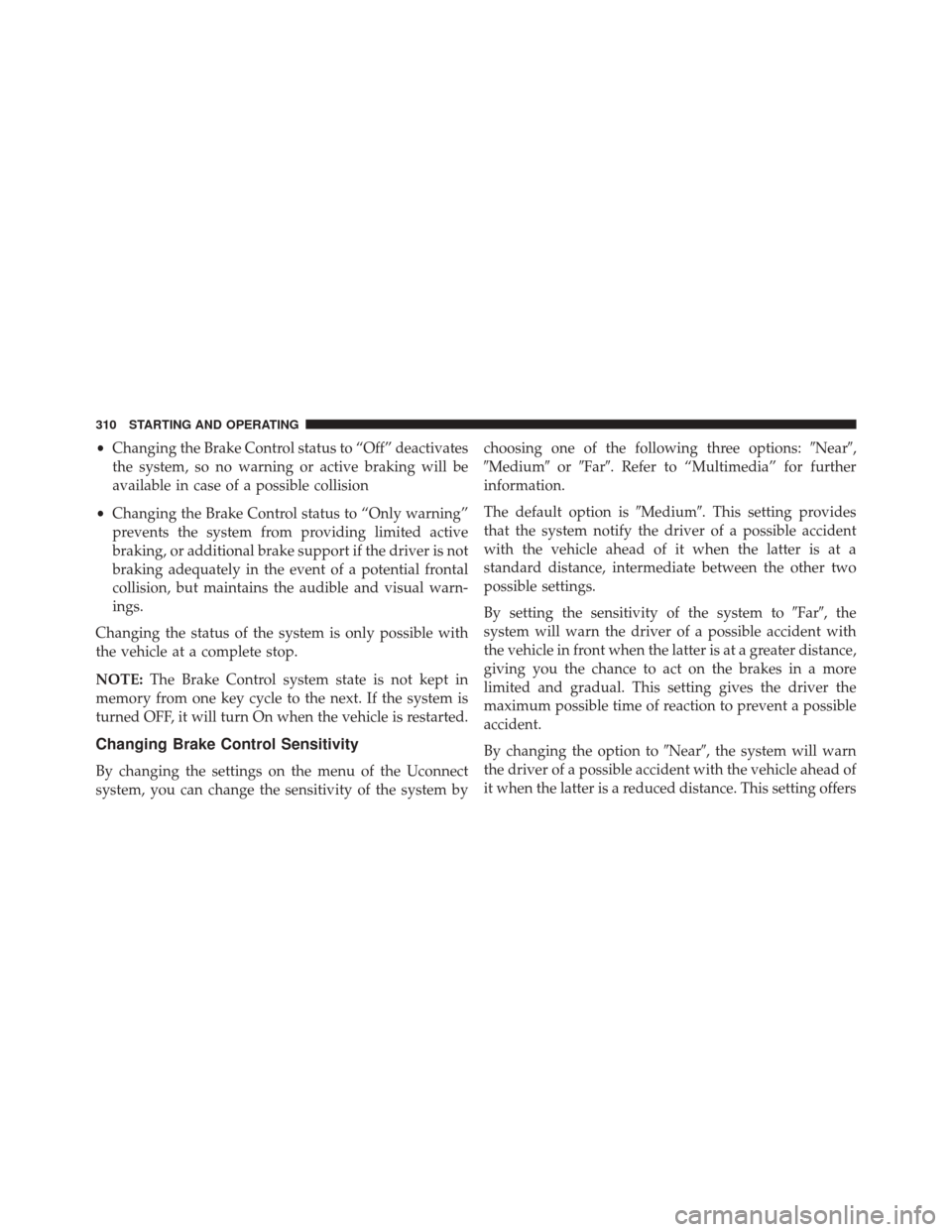Page 305 of 587

WARNING!
Leaving the Electronic Speed Control system on
when not in use is dangerous. You could accidentally
set the system or cause it to go faster than you want.
You could lose control and have an accident. Always
leave the system OFF when you are not using it.
Setting A Desired Speed
Turn the Speed Control ON.
NOTE:The vehicle should be traveling at a steady speed
and on level ground before pushing the SET (+) or SET (-)
button.
When the vehicle has reached the desired speed, push the
SET (+) or SET (-) button and release. Release the
accelerator and the vehicle will operate at the selected
speed.
Deactivation
A soft tap on the brake pedal, pushing the CANCEL
button, ESC intervention, Forward collision mitigation,
Electronic Park Brake Intervention, or normal brake
pressure while slowing the vehicle will deactivate the
Speed Control without erasing the set speed from
memory.
Pushing the ON/OFF button or turning the ignition
switch OFF erases the set speed from memory.
Resume Speed
To resume a previously set speed, push the RES button
and release. Resume can be used at any speed above
20 mph (32 km/h).
7
STARTING AND OPERATING 303
Page 309 of 587

All Weather Mode –This mode offers increased traction
control and stability control for low traction conditions
such as driving in snow or rain.
Sport Mode – This mode is designed to increase steering
feedback to the driver with a slight increase in effort and
changes the transmission shift schedules for more aggres-
sive shifting. This driving mode is useful while driving
on twisty roads where more steering precision is desired
in spirited cornering.
Warning Messages
In the event of a system fault, the system automatically
defaults to �Auto�mode and a message will appear in the
EVIC display.
Refer to “Electronic Vehicle Information Center (EVIC)”
in “Getting To Know Your Instrument Cluster” for fur-
ther information.
BRAKE CONTROL — IF EQUIPPED
Brake Control
The Brake Control system with mitigation provides the
driver with audible warnings, visual warnings (within
the EVIC), and may apply a brake jerk to warn the driver
when it detects a potential frontal collision. The warnings
and limited braking are intended to provide the driver
with enough time to react, avoid or mitigate the potential
collision.
NOTE:
• Brake Control monitors the information from the for-
ward looking sensors as well as the Electronic Brake
Controller (EBC), to calculate the probability of a
forward collision. When the system determines that a
forward collision is probable, the driver will be pro-
vided with audible and visual warnings and may
provide a brake jerk warning.
7
STARTING AND OPERATING 307
Page 310 of 587

•If the driver does not take action based upon these
progressive warnings, then the system will provide a
limited level of active braking to help slow the vehicle
and mitigate the potential forward collision. If the
driver reacts to the warnings by braking and the
system determines that the driver intends to avoid the
collision by braking but has not applied sufficient
brake force, the system will compensate and provide
additional brake force as required.
Vehicles With A Manual Transmission: After the end of
the intervention of automatic braking, the engine could
stall, unless the driver can depress the clutch pedal.
Vehicles With Automatic Transmission: After the end of
the intervention of automatic braking, the transmission
may remain in last gear stored: therefore the car could
lurch forward, once the brakes release a few seconds
later. If the Brake Control event stops the vehicle com-
pletely, the system will hold the vehicle at standstill for
two seconds and then release the brakes. If a Brake Control event begins at a speed below 20 mph
(32 km/h), the system may provide the maximum brak-
ing possible to mitigate the potential forward collision. If
the Brake Control event stops the vehicle completely, the
system will hold the vehicle at standstill for two seconds
and then release the brakes.
Brake Control Message
308 STARTING AND OPERATING
Page 311 of 587

When the system determines a collision with the vehicle
in front of you is no longer probable, the warning
message will be deactivated.
NOTE:
•The minimum speed for Brake Control activation is
4 mph (7 km/h).
• The maximum speed for Brake Control activation is
124 mph (200 km/h).
• The Brake Control alerts may be triggered on objects
other than vehicles such as guard rails or sign posts
based on the course prediction. This is expected and is
a part of normal Brake Control activation and func-
tionality.
• The Brake Control system is intended for on-road use
only. If the vehicle is taken off-road, the Brake Control
system should be deactivated to prevent unnecessary
warnings to the surroundings. •
The system is active only if the front seat belts are
fastened.
WARNING!
Brake Control is not intended to avoid a collision on
its own, nor can Brake Control detect every type of
potential collision. The driver has the responsibility
to avoid a collision by controlling the vehicle via
braking and steering. Failure to follow this warning
could lead to serious injury or death.
Turning Brake Control ON Or OFF
The Brake Control menu setting is located in the
Uconnect settings.
NOTE: The default status of Brake Control is “Warning +
Active Braking,” this allows the system to warn you of a
possible collision with the vehicle in front of you and
enable the active braking.
7
STARTING AND OPERATING 309
Page 312 of 587

•Changing the Brake Control status to “Off” deactivates
the system, so no warning or active braking will be
available in case of a possible collision
• Changing the Brake Control status to “Only warning”
prevents the system from providing limited active
braking, or additional brake support if the driver is not
braking adequately in the event of a potential frontal
collision, but maintains the audible and visual warn-
ings.
Changing the status of the system is only possible with
the vehicle at a complete stop.
NOTE: The Brake Control system state is not kept in
memory from one key cycle to the next. If the system is
turned OFF, it will turn On when the vehicle is restarted.
Changing Brake Control Sensitivity
By changing the settings on the menu of the Uconnect
system, you can change the sensitivity of the system by choosing one of the following three options:
�Near�,
�Medium� or�Far�. Refer to “Multimedia” for further
information.
The default option is �Medium�. This setting provides
that the system notify the driver of a possible accident
with the vehicle ahead of it when the latter is at a
standard distance, intermediate between the other two
possible settings.
By setting the sensitivity of the system to �Far�, the
system will warn the driver of a possible accident with
the vehicle in front when the latter is at a greater distance,
giving you the chance to act on the brakes in a more
limited and gradual. This setting gives the driver the
maximum possible time of reaction to prevent a possible
accident.
By changing the option to �Near�, the system will warn
the driver of a possible accident with the vehicle ahead of
it when the latter is a reduced distance. This setting offers
310 STARTING AND OPERATING
Page 313 of 587

a reaction time to the driver lower than the settings
�Medium�and�Far�, in the case of a potential accident,
while a more dynamic driving of the car.
The setting of the sensitivity of the system is maintained
in memory when the engine is switched off.
Brake Control Limited Warning
If the EVIC displays “Brake Control Limited Functional-
ity” or “Brake Control Limited Functionality Clean Front
Windshield” momentarily, there may be a condition that
limits Brake Control functionality. Although the vehicle is
still drivable under normal conditions, the active braking
may not be fully available. Once the condition that
limited the system performance is no longer present, the
system will return to its full performance state. If the
problem persists, see your authorized dealer.
Service Brake Control Warning
If the system turns off, and the EVIC displays:
• Brake Control Unavailable Service Required
This indicates there is an internal system fault. Although
the vehicle is still drivable under normal conditions, have
the system checked by an authorized dealer.
“Wipe Front Radar Sensor In Front Of Vehicle” Warn-
ing
The “Brake Control Front Radar Sensor Temporarily
Blocked” warning will display when conditions tempo-
rarily limit system performance. This most often occurs
at times of poor visibility, such as in snow or heavy rain.
The system may also become temporarily blinded due to
obstructions, such as mud, dirt or ice. In these cases, the
EVIC will display “Brake Control Front Radar Sensor
Temporarily Blocked” and the system will deactivate.
7
STARTING AND OPERATING 311
Page 314 of 587

The “Brake Control Front Radar Sensor Temporarily
Blocked” message can sometimes be displayed while
driving in highly reflective areas (i.e. tunnels with reflec-
tive tiles, or ice and snow). The system will recover after
the vehicle has left these areas. Under rare conditions,
when the radar is not tracking any vehicles or objects in
its path this warning may temporarily occur.
If weather conditions are not a factor, the driver should
examine the sensor. It may require cleaning or removal of
an obstruction. The sensor is located behind the lower
grille. In absence of visible obstructions on the bumper, it
could be necessary to wipe off the radar directly on the
surface, after having the radar cover removed. It’s rec-
ommended that your authorized dealer perform’s this
operation.NOTE:
•
If the “Brake Control Front Radar Sensor Temporarily
Blocked” message occurs frequently (e.g. more than
once on every trip) without any snow, rain, mud, or
other obstruction, have the radar sensor realigned at
your authorized dealer.
• Installing a snow plow, front-end protector, an after-
market grille or modifying the grille is not recom-
mended. Doing so may block the sensor and inhibit
Brake Control operation.
312 STARTING AND OPERATING
Page 323 of 587

WARNING!
•Drivers must be careful when backing up even
when using the Rear Park Assist system. Always
check carefully behind your vehicle, look behind
you, and be sure to check for pedestrians, animals,
other vehicles, obstructions, and blind spots before
backing up. You are responsible for safety and
must continue to pay attention to your surround-
ings. Failure to do so can result in serious injury or
death.
• Before using the Rear Park Assist System, it is
strongly recommended that the ball mount and
hitch ball assembly is disconnected from the ve-
hicle when the vehicle is not used for towing.
Failure to do so can result in injury or damage to
vehicles or obstacles because the hitch ball will be
much closer to the obstacle than the rear fascia
(Continued)
WARNING! (Continued)
when the warning display turns on the single
flashing arc and sounds the continuous tone. Also,
the sensors could detect the ball mount and hitch
ball assembly, depending on its size and shape,
giving a false indication that an obstacle is behind
the vehicle.
If it’s necessary to keep the trailer hitch and hitch ball
assembly mounted for a long period, it is possible to filter
out the trailer hitch and hitch ball assembly presence in
sensor field of view. The filtering operation must be
performed only by an authorized dealer.
LANESENSE — IF EQUIPPED
LaneSense Operation
The LaneSense system is operational at speeds above
37 mph (60 km/h) and below 112 mph (180 km/h). The
7
STARTING AND OPERATING 321